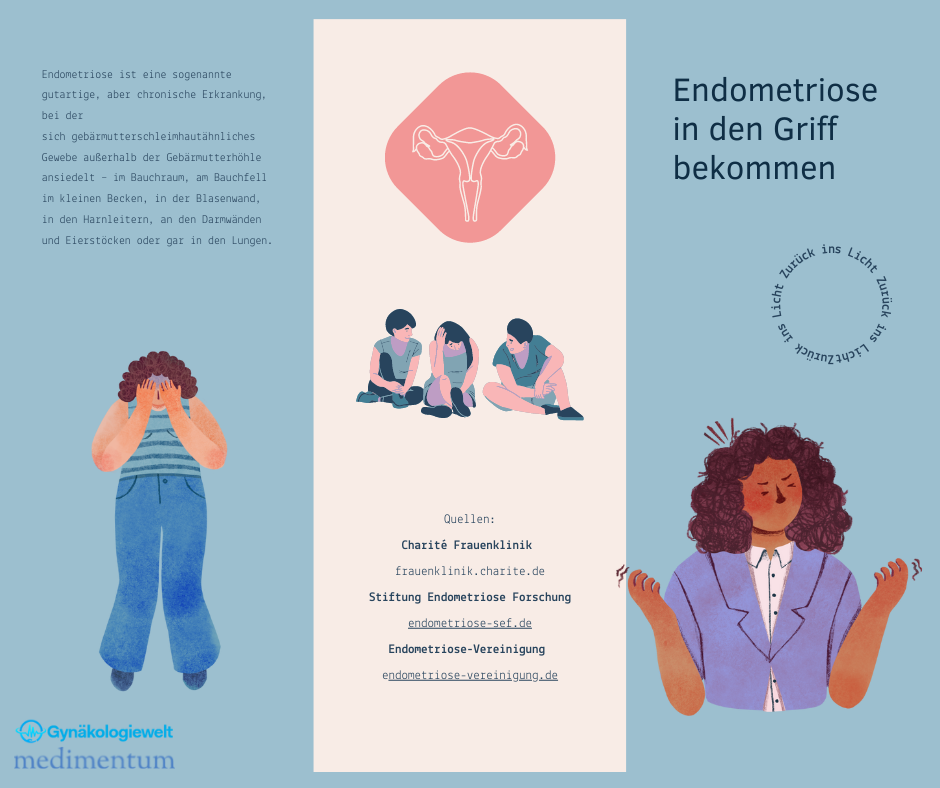Endometriosis is one of the most common chronic diseases in sexually mature women, which causes extremely severe pain, but is still underestimated — also in medicine.
A widespread disease
Endometriosis is probably the most common benign abdominal disease in women. Experts expect up to 40,000 new cases per year in Germany alone. However, only a fraction of the cases are known. The disease often goes undiagnosed. One of the main reasons is certainly that, in addition to the endometriosis-specific symptoms, non-specific complaints can distort the clear symptoms, which means that not only gynecologists but also doctors from other disciplines are consulted by the women concerned.
Endometriosis can appear in various anatomical forms
Endometrium-like tissue can settle in a variety of places in the abdomen. A distinction is made between forms of endometriosis according to their location and severity:
- outside the genital organs (technical term: endometriosis genitalis externa),
- the diffuse and focal form of adenomyosis (technical term: endometriosis genitalis interna),
- Endometriosis that grows into other organs, i.e. deeply infiltrating (TIE for short),
- as well as endometriosis foci on organs other than the genital organs (technical term: endometriosis extragenitalis), for example on the diaphragm or navel (can be both inside and outside the abdomen).
Endometriosis and Adenomyosis
Endometriosis is a benign but chronic disease in which tissue similar to the lining of the uterus grows outside the uterine cavity — in the abdomen (peritoneum), on the peritoneum in the small pelvis, in the bladder wall, in the ureters, on the intestinal walls and ovaries or even in the lungs . The name derives from the Greek word endometrium for uterine lining. In the meantime, however, it is known that this is not just tissue similar to the lining of the uterus (epithelial and stromal cells), but also smooth muscle cells that resemble the musculature of the uterus. Originally, the medical term endometriosis (endometriosis outside the uterine cavity) described endometriosis foci on the peritoneum and in the genital organs (endometriosis genitalis externa). But now it also means the migration of such foci into the uterine muscle wall (endometriosis genitalis interna or adenomyosis uteri, adenomyosis for short).
It is important to know the subtypes of endometriosis in order to understand the full picture of the disease. Both (endometriosis and adenomyosis) belong together, which is why the entire clinical picture should actually be called archimetrosis, since it starts in a part of the uterus (technical term: archimetra). However, not as much is known about adenomyosis as about endometriosis. One of the reasons for this is that the uterus is not usually removed from young women, but rather a laparoscopy is used to determine whether endometriosis can be seen. So the uterus is forgotten in most cases. With the introduction of the “laparoscopy” surgical technique, the focus has been placed more on endometriosis than on adenomyosis. Thus, for many decades, research has only dealt with a part of the entire endometriosis disease.
The chronic disease is characterized by numerous symptoms
Since both adenomyosis and endometriosis are hormone-dependent diseases, the symptoms or complaints initially occur cyclically, i.e. mostly according to a pattern that is always the same, for example always before, during or after the menstrual period. The patterns are as individual as the patients and their disease, which makes it difficult to diagnose endometriosis correctly. In the further course of the disease, the symptoms can also appear acyclically — this does not make the diagnosis any easier either. Typical overriding symptoms of both diseases include heavy bleeding, pain and infertility. The main symptom of endometriosis and adenomyosis is always painful menstrual bleeding, but unwanted childlessness, pain during sexual intercourse or urination and other abdominal pain can also be indications.
Due to the complexity of the entire clinical picture, the diagnosis and the treatment, many patients suffer from the numerous symptoms and cannot be adequately cared for due to a lack of comprehensive expertise. In this case, certified endometriosis centers or self-help groups can be supportive to share experiences, problems or life situations. Below you will find an overview of the most important contact points for those affected.
Addresses that help affected women:
Charité — University Medicine Berlin
Augustenburger Platz 1, 13353 Berlin | www.frauenklinik.charite.de
At the Charité Virchow Klinikum (CVK), Prof. Sylvia Mechsner heads a certified Level III endometriosis center. It is one of the largest endometriosis centers in Germany, treating more than 500 patients every year.
Endometriosis Research Foundation
Lange Straße 38, 26655 Westerstede | www.endometriose-sef.de
The Endometriosis Research Foundation wants to improve knowledge about the disease endometriosis in Germany and change the situation for the benefit of the women affected. The foundation works closely with the European Endometriosis League and the German Endometriosis Association. You can find the addresses of certified endometriosis rehabilitation clinics on the Foundation’s website.
European Endometriosis League
www.euroendometriosis.com bei Facebook: @europaeischeendometrioseliga
The European Endometriosis League supports research and raises public awareness of endometriosis in European countries. The aim is to improve awareness and treatment for women with endometriosis.
Endometriosis Association Germany e.V.
Bernhard-Göring-Str. 152, 04277 Leipzig | www.endometriose-vereinigung.de
The Self-Help Association provides endometriosis information and support, as well as free counseling. Here you will also find a list of the addresses of specialists, certified endometriosis centers in Germany and other contact points.

